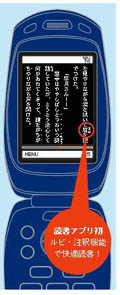 Peter Brantley points to an interesting WSJ piece (free) on the explosion of Japanese cellphone fiction. These are works, often the length of novels, composed specifically for consumption via the phone’s tiny screen. In some cases, they are even written on the phone. Stories are written in terse, unadorned language, in chunks crafted specifically to fit on a single mobile screen. Dialog is favored heavily over narrative description, and from the short excerpts I’ve read, the aim seems to be to conjure cinematic imagery with the greatest economy of words. The WSJ reproduces this passage from Satomi Nakamura’s “To Love You Again”:
Peter Brantley points to an interesting WSJ piece (free) on the explosion of Japanese cellphone fiction. These are works, often the length of novels, composed specifically for consumption via the phone’s tiny screen. In some cases, they are even written on the phone. Stories are written in terse, unadorned language, in chunks crafted specifically to fit on a single mobile screen. Dialog is favored heavily over narrative description, and from the short excerpts I’ve read, the aim seems to be to conjure cinematic imagery with the greatest economy of words. The WSJ reproduces this passage from Satomi Nakamura’s “To Love You Again”:
Kin Kon Kan Kon (sound of school bell ringing)
(space)
The school bell rang
(space)
“Sigh. We’re missing class”
(space)
She said with an annoyed expression.
This novel clocks in at 200 pages, and was written entirely with Nakamura’s thumb!
About seven years ago, some of these works started making their way into print, initially through self-publishing websites like Maho i-Land. But the popularity of mobile novels soon caught the attention of mainstream publishers and numerous titles have been made into bona fide hits in print, some selling into the millions, with film adaptations, the whole bit.
But if any industry lesson can be taken from this mini case study of Japanese cellphone fic, it’s not the potential for crossover into print, but that emergent electronic literary forms will most likely find their economic model in services and subscriptions rather than in the sale of copies. The WSJ article suggests that the mobile lit genre exploded in Japan in no small part due to recent changes in service options from cellular providers.
About three years ago, phone companies began offering high-speed mobile Internet and affordable flat-rate plans for transmitting data. Users could then access the Internet as much as they wanted to for less than $50 a month.
The now-bustling Maho i-Land has six million members, and the number of mobile novels on its site has jumped, to more than a million today from about 300,000 before the flat-rate plans cut phone bills in half. According to industrywide data cited by Japan’s largest cellphone operator NTT DoCoMo Inc., sales from mobile-book and comic-book services are expected to more than double, to more than $200 million from about $90 million last year.
This would suggest that at least part of the reason cellphone novels haven’t taken off here in the States is the comparatively impoverished service we get from our mobile providers, and the often extortionist rates we pay. True, the mobile lit genre was already a phenomenon there before the rejiggering of service plans, which suggests there were preexisting cultural conditions that led to the emergence of the form: readers’ already well developed appetites for serial comics perhaps, or the peculiar intensity of keitai fetishism. In other words, improved telcom services in the States wouldn’t necessarily translate into a proliferation of cellphone novels, but other mobile media services would undoubtedly start to flourish. Broadband internet access is also pathetically slow in the US compared to countries in Europe and East Asia – ?the Japanese get service eight to 30 times faster than what we get over here. What other new media forms are being stifled by the crappiness of our connections?

another interesting phenomenon this suggests is that art is irrepressible as it emerges and pokes its way through the smallest of cracks in the media firmament. publishers have spent a lot of money trying to make a business of selling PDFs of books. but there’s a disconnect between the content and the form (incl. the reading surfaxe) and this has yet to get any kind of traction in the marketplace, while at the same time, someone comes along and creates a new art form appropriate to its specific medium and it takes off, not just commercially but more importantly in terms of the creativity of the output. the fact that these phone works are migrating to other forms is a testament to the creative vitality of the work.
Agreed. These aren’t conventional fiction works crammed into phones, they are written very much with that particular device in mind. And I’m told that writers sometimes use aspects of the technology as narrative devices… a mystery begins with an errant text message etc. I think exciting new forms always emerge through this kind of on-the-ground resourcefullness, not through industry calculations.
bob said:
> art is irrepressible as it
> emerges and pokes its way
> through the smallest of cracks
> in the media firmament
yes. yes, yes, yes.
-bowerbird
Hi Peter
Do you have the website or email address of Starts Publishing Corp?
Thanks